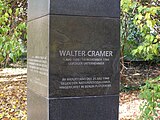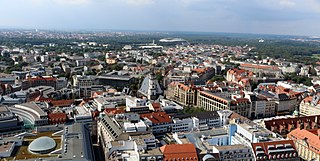
Leipzig is the most populous city in the German state of Saxony. The city has a population of 628,718 inhabitants as of 2023. It is the eighth-largest city in Germany and is part of the Central German Metropolitan Region. The name of the city is usually interpreted as a Slavic term meaning place of linden trees, in line with many other Slavic placenames in the region.

Peter Joseph Lenné was a Prussian gardener and landscape architect. As director general of the Royal Prussian palaces and parks in Potsdam and Berlin, his work shaped the development of 19th-century German garden design in the Neoclassical style. Laid out according to the principles of the English landscape garden, his parks are now World Heritage Sites.

Markkleeberg is an affluent suburb of Leipzig, located in the Leipzig district of the Free State of Saxony, Germany. The river Pleiße runs through the city, which borders Leipzig to the north and to the west.
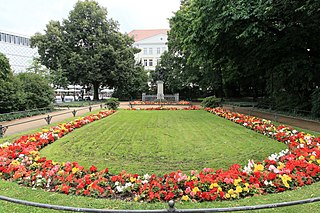
Goerdelerring is a street and major tram interchange station in Leipzig, Germany. It is named after Carl Friedrich Goerdeler.

The Augustusplatz is a square located at the east end of the city centre of Leipzig, borough Leipzig-Mitte. It is the city's largest square and one of the largest squares in Europe. It is also part of the city's inner-city ring-road and a central hub for its tram network.
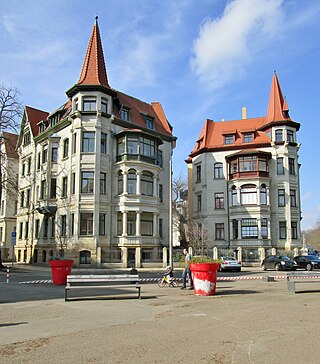
Waldstraßenviertel, is a neighbourhood in the north west of Leipzig's borough Mitte in Saxony, Germany. It is considered one of the largest complete areas of Gründerzeit buildings in Europe and is therefore considered of important cultural and heritage status. Many of its buildings are therefore protected or listed.
Neurossgarten was a quarter of northwestern Königsberg, Germany. Its territory is now part of Kaliningrad, Russia.
Nasser Garten or Nassengarten was a quarter of Königsberg, Germany, located southwest of the city center. Its territory is now part of the Moskovsky District of Kaliningrad, Russia.

Walter Arnold was a German stonemason and sculptor. Between 1957 and 1964 he was the president of the Association of Visual Artists in East Germany.

The Palmengarten is a park in Leipzig-Lindenau. It covers a surface of 22.5 hectares.

Roswitha Trexler is a German operatic soprano and mezzo-soprano who became internationally known especially as an interpreter of the music of Hans Eisler and for her commitment to avantgarde vocal music.

Hubert Hans Ritter was a German architect, urban planner and building official.
From 1959 to 1989, the city of Leipzig awarded the Kunstpreis der Stadt Leipzig, which was given for outstanding merits in the artistic field to persons who promoted the reputation of the city beyond the region: architects, visual artists, composers, musicians, singers, actors and writers as well as literary and art critics.

The Forum Thomanum is a music educational campus developed from 2002 in Leipzig, Saxony, Germany, as the new home of the Thomanerchor which was founded in 1212. It was conceived in 2002 by Georg Christoph Biller, then Thomaskantor, and others, to provide an internationally oriented innovative campus for a future of the traditional choir which was defined until then by Thomaskirche and Thomasschule.

The Inner City Ring Road in Leipzig in the district of Mitte is the ring road around Leipzig's city centre. It encloses the just 0.7 km2 (0.27 sq mi) large area of the old town without the former Vorstadts.
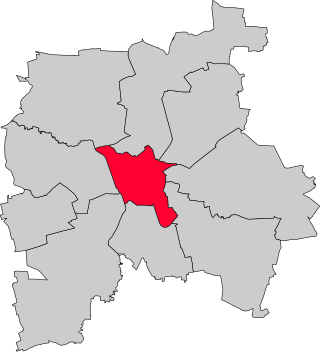
Leipzig-Mitte is one of ten boroughs (Stadtbezirke) of Leipzig, located in the center of the city. It includes numerous architectural monuments. Most of them are located in the subdivision "Zentrum", which is sited inside the Inner City Ring Road and the Promenadenring:

The Clara-Zetkin-Park is a park in Leipzig. From 1955 until 2011 it was Leipzig's largest park with an area of 125 hectares and was called Zentraler Kulturpark Clara Zetkin. The name was changed in 2011 and since then the Johannapark and the Palmengarten have officially been considered independent parks.

The Promenadenring Leipzig is the oldest municipal landscape park in Germany and one of the most important garden and cultural monuments in the city. The term is also used as a synonym for Leipzig's inner city ring road, a traffic facility that is connected to the green spaces of the Promenadenring. Like the inner city ring road, the promenade ring is about 3.6 kilometers long (2.24 mi.).
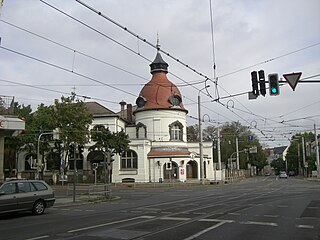
Karl-Heine-Strasse is a radial road in the west of Leipzig marking the boundary between the current boroughs of Leipzig-Plagwitz and Leipzig-Lindenau . 2.01 km (1.2 mi) long, it is named after the industrialist Karl Heine.

Grimmaische Strasse is a street in Leipzig, borough Leipzig-Mitte, and connects the marketplace with Augustusplatz. It was named in 1839 after the Grimmaischer Tor, the gateway to Grimma, which was first mentioned in 1421. Before that it was called Grimmaische Gasse and was the main street of the Grimma quarter. Today it is a heavily frequented pedestrian zone in a prime location with department stores, shops, restaurants, hotels, a museum and the university as residents.







